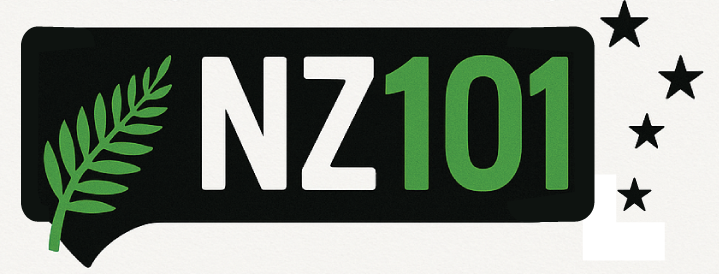Whether you’re a self-proclaimed bird nerd (which I’m definitely not!) or simply someone who treasures the sound of morning melodies (that’s more my style!), New Zealand is nothing short of magical.
Even living in the bustling suburbs of Auckland like I do, I’m constantly surrounded by a chorus of native birds that makes you forget you’re actually living in a city.
My Tūī Neighbour
While I’m still learning to match songs to species, there’s one voice I’d recognise anywhere: that of the enchanting tūī. My neighbourhood has its very own feathered celebrity who lives in a tree just outside my window. Every morning, as the first rays of sunshine poke through my blinds, this tūī delivers the most spectacular wake-up call imaginable. No alarm clock could beat this daily concert. It reminds me how lucky I am to call New Zealand home.
Bird of the Year
New Zealanders are very proud and protective of their birds. Of course, there is the kiwi bird, which is the national bird of New Zealand (more about that flightless creature below), but there is even a Bird of the Year.
Every year, Kiwis from all walks of life campaign fiercely for their feathered favourites. Social media battles, clever marketing campaigns and even celebrity endorsements emerge as people cast their ranked votes for nominated native birds.
Run by the conservation organisation Forest & Bird, this beloved tradition is far more than just a bit of fun. It is a genuine mission to spotlight our precious native species, many of which face serious threats.
If you want to read about New Zealand birds, visit New Zealand Birds Online. It is a comprehensive database with detailed information about all 482 species of New Zealand birds, including those that are extinct.
New Zealand is home to 206 breeding bird species, of which 94 are found only in New Zealand.
I obviously can’t list them all in this blog post, so here are my five favourite birds.
Kiwi

Of course, it makes sense to start with New Zealand’s national bird and unofficial national emblem: the kiwi. I would be in serious trouble with the locals if I didn’t include the kiwi in my list of favourite birds.
A strange bird
The kiwi is unique. It cannot fly and has loose, hair-like feathers. It is also nocturnal, so few New Zealanders have ever seen it in real life.
Another interesting fact about the kiwi is the size of the egg. In relation to the bird’s body size, the egg is about one-fifth of the female’s weight. Imagine that! And here I thought giving birth to a 3 kg baby was hard work!
Apparently, the kiwi became flightless because it had no predators for millions of years. Of course, things have changed since its days of roaming the country freely and undisturbed. It is estimated that back in their heyday, there were 12 million kiwi (the plural of ‘kiwi’ is also ‘kiwi’, not ‘kiwis’), but by 2006, there were fewer than 100,000 left. As a result, the kiwi were given official protection and several conservation initiatives were developed.
A national icon
So, you may wonder why this curious bird became such a national icon.
The kiwi became a representation of New Zealand in the early 1900s when cartoonists started to use the kiwi when referring to the New Zealand rugby team (the All Blacks). By the end of World War I, the New Zealand soldiers were referred to as Kiwis.
If you want to learn more about this strange bird, I recommend visiting:
Te Ara website, The Encyclopedia of New Zealand
The Department of Conservation
Kererū or New Zealand Wood Pigeon

Now that we have the kiwi out of the way, let’s talk about a bird with a sense of humour: the kererū or more commonly known as the wood pigeon.
It may not be New Zealand’s national icon, but it was well-deservedly named the Bird of the Year in 2018. Check it out on the Bird of the Year website. The Guardian even devoted an entire article to this native green and bronze pigeon.
The drunkest bird in New Zealand
When the kererū (plural is also ‘kererū’) eat ripe fruit and sit in the sun to digest, the fruit ferments and produces alcohol, making the bird drunk. It makes them fall from trees, collide with windows and ‘act like clowns’. In summer, when berries are abundant, drunk kererū are sometimes taken to wildlife centres to sober up, a bit like a drunk driver stopped at a checkpoint and made to spend the night in a police cell.
Importance of the kererū
On a more serious note, the kererū is a beautiful pigeon that plays an important role in the regeneration of forests, as it is the only fruit-eating bird left in New Zealand large enough to swallow fruit with large seeds, which is necessary for the spread of trees for generations to come. If you’re interested in reading more about the importance of the kererū, check out Pigeons – kererū and parea.
Tūī

I’ve already mentioned why I love the tūī. Nothing beats waking up to the song of this amazing bird.
I have a single tūī bird just outside my bedroom window, and it happily sings all by itself, every morning without fail.
This bird is not only a vocal champion, but it is not too bad-looking either. Tūī are dark green with purple and azure highlights, and they have two white feathers under the chin, which makes it easy to spot them in nature.
Head to Te Ara if you want to read more about this impressive bird, or visit Bird of the Year and search under ‘tūī’ to listen to its mesmerising song.
Pūkeko

Pūkeko live near wetlands, which is probably why I encounter them daily, as I live near an estuary north of Auckland.
They are quite large birds with long legs. They usually walk, flicking their tail with each step, showing the white patch underneath, making them one of New Zealand’s most recognisable birds. They can also swim.
The pūkeko has deep blue-purple plumage, a bright red bill and frontal shield, and long red legs.
In Māori culture, the pūkeko features in several legends and was hunted for food. The bird’s determination and adaptability are admired traits in Māori tradition.
I find the pūkeko really cute, but it seems to have a mixed reputation among New Zealanders.
Apparently, they are agricultural pests, so they are not very popular among farmers.
They also have a tendency to walk across roads rather than fly, leading to collisions with vehicles.
And there are lots of them, which is why they don’t get the same level of conservation sympathy from New Zealanders like kiwi.
They’re also territorial and can be quite aggressive in defending their territory. They often damage gardens and golf courses.
However, the pūkeko is well respected because of its success story among native birds.
Visit Te Ara for a detailed description of the pūkeko.
Hoiho or Yellow-Eyed Penguin: Bird of the Year 2024

I thought it was only appropriate to include the 2024 Bird of the Year: the hoiho or yellow-eyed penguin.
Admittedly, I did not vote for this bird. Quite frankly, I can’t remember which bird got my vote, but I doubt it was this penguin, as I had never heard of it. But now I understand why it has twice been the Bird of the Year.
This large penguin with yellow eyes is endangered, with a population of fewer than 4,000 birds.
It features on New Zealand’s $5 note and has significant cultural importance. The name ‘hoiho’ means ‘noise shouter’ in Māori, referring to their loud, distinctive call.
While wildlife tourism centred around viewing hoiho has brought awareness to their plight, it can also cause stress to the birds if not managed properly. Climate change is also affecting their food supply.
There are significant conservation efforts in place to protect the hoiho, such as viewing areas that allow people to observe the penguins without disturbing them.
Check out more info on this very pretty penguin at Te Ara and Bird of the Year 2024: A Peng-win for the penguin.
There you have it—my five favourite New Zealand birds. If you would like me to write about any other native bird, please email me at kat@nzforbeginners.com.



Pingback: Weekly Whirl #10 - New Zealand for Beginners